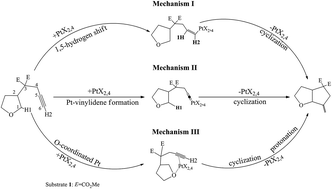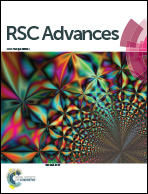Direct coupling of unactivated alkynes and C(sp3)–H bonds catalyzed by a Pt(ii, iv)-centered catalyst: a computational study†
Abstract
Direct coupling of unactivated alkynes and C(sp3)–H bonds catalyzed by a Pt(II, IV)-centered catalyst X (X = PtCl2, PtBr2, PtI2 and PtI4) (J. Am. Chem. Soc. 2009, 131, 16525) have been theoretically investigated with density functional theory (DFT). A comprehensive mechanistic DFT study of these reactions was carried out to better understand the experimental outcomes, and divergent and substrate-/catalyst-dependent mechanisms for the formation of ether derivatives were uncovered based on the computational results. Free energy diagrams for three types of mechanisms were computed, (a) in Mechanism I, the transition state implies a directed 1,5-hydrogen shift (pathways a1–a4), (b) Mechanism II leads to the formation of a Pt(II, IV) vinyl carbenoid (pathway b), and (c) Mechanism III involves an O-coordinated Pt and includes 5,6-hydrogen migration (pathway c). Results suggest that the catalytic mechanism with PtI4 is different to PtCl2, PtBr2 and PtI2 catalysts. When PtCl2, PtBr2 and PtI2 were used the insertion reaction pathway a2 is favored while PtI4 adopted the pathway a1. Comparing the energy profiles, the pathway a1 with PtI4 is the most favored. Through 1,5-hydrogen transfer, the concerted insertion pathway a1 with carbocationic intermediate is favored while the vinyl carbenoid mechanism is implausible.


 Please wait while we load your content...
Please wait while we load your content...